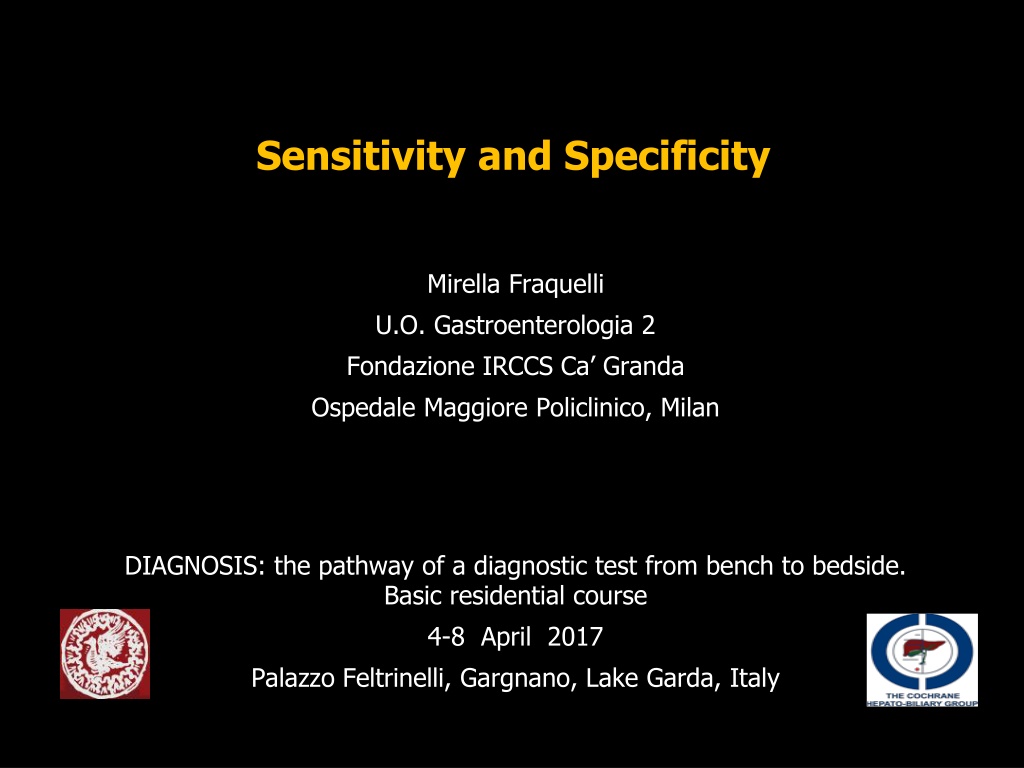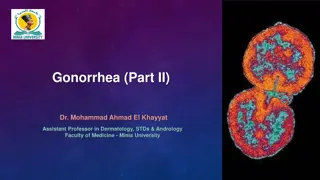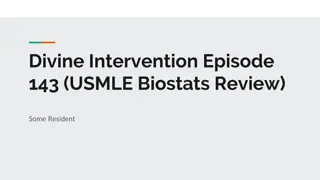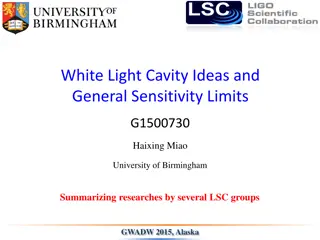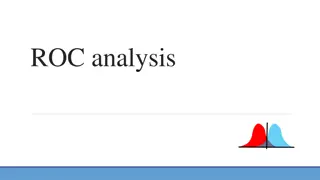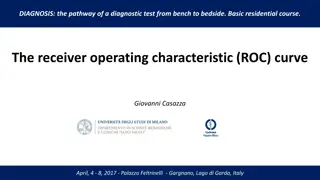Understanding Sensitivity and Specificity in Diagnostic Testing
Sensitivity and specificity are crucial measures in evaluating the accuracy of diagnostic tests. Sensitivity reflects the test's ability to correctly identify individuals with a particular condition, while specificity indicates its ability to correctly identify those without the condition. This comprehensive overview covers the basic concepts, study design, and estimation methods related to sensitivity and specificity, along with a clinical example illustrating their practical application in diagnosing acute cholecystitis.
Uploaded on Sep 30, 2024 | 0 Views
Download Presentation

Please find below an Image/Link to download the presentation.
The content on the website is provided AS IS for your information and personal use only. It may not be sold, licensed, or shared on other websites without obtaining consent from the author. Download presentation by click this link. If you encounter any issues during the download, it is possible that the publisher has removed the file from their server.
E N D
Presentation Transcript
Sensitivity and Specificity Mirella Fraquelli U.O. Gastroenterologia 2 Fondazione IRCCS Ca Granda Ospedale Maggiore Policlinico, Milan DIAGNOSIS: the pathway of a diagnostic test from bench to bedside. Basic residential course 4-8 April 2017 Palazzo Feltrinelli, Gargnano, Lake Garda, Italy
Sensitivity and Specificity Accuracy of a diagnostic test the ability of a test (Index Test) to distinguish between patients with and subjects without the target condition Target condition a particular disease, disease stage or health status that should prompt clinical action Reference standard the best available (Benchmark), reliable and usually invasive test to define the presence of the target condition
Study design Basic design of diagnostic accuracy studies: Prospective, blinded cross classification of test and reference standard in a clinically relevant setting TP Liver biopsy FP Relevant spectrum of patients TE FN Liver biopsy TN
Sensitivity and Specificity Sensitivity = proportion of people with the disease who will have a positive test Specificity = proportion of people without the disease who will have a negative test
Estimates of diagnostic accuracy Disease Status Present Absent Test Positive TP FP TP+FP Test Negative FN TN FN+TN FP+TN TP+FN TP+FN+FP+TN Sensitivity = TP/(TP+FN) Sensitivity: proportion of positive test results among participants with the target condition.
Estimates of diagnostic accuracy Disease Status Present Absent Test Positive TP FP TP+FP Test Negative FN TN FN+TN TP+FN FP+TN TP+FN+FP+TN TP+FN+FP+TN TP+FN+FP+TN Specificity = TN/(FP+TN) Specificity: proportion of negative test results among participants without the target condition.
A clinical example . 164 consecutive subjects with suspected acute cholecystitis underwent US and surgical pathology/follow-up (reference standard) Test CD Present Absent +ve 20 26 46 -ve 3 115 118 23 141 264 Sensitivity= 20/23= 86.9% Summers et al. - Ann Emerg Med 2010
A clinical example . 164 consecutive subjects with suspected acute cholecystitis underwent US and surgical pathology/follow up (reference standard) Test CD Present Absent +ve 20 26 46 -ve 3 115 118 23 141 264 Specificity= 115/141= 81.5% Summers et al. - Ann Emerg Med 2010
Sensitivity vs Specificity A sensitive test is more valuable in situations where it is useful to reduce false negative results A specific test is more valuable in situations where it is useful to reduce false positive results
Assessing new tests against existing diagnostic pathways Remember the purpose of your test ! Triage Add on Replacement EACH SITUATION MAY REQUIRE DIFFERENT TEST FEATURES!
Add-on Existing situation Replacement Triage Population Population Population Population Initial test Initial test Initial test New test + Existing test New test Existing test - Existing test - - - + + + New test - + + - Bossuyt et al. BMJ 2006;332:1089-1092
Mnemonic shortcut SnOUT & SpIN SPIN SNOUT High-specificity test High-sensitivity test if Positive if Negative Rule the diagnosis in Rule the diagnosis out
Mnemonic shortcut SnOUT & SpiN Warning! Rule of Thumbs Can be misleading Sensitivity and specificity must always be considered together in assessing the validity of a test
Sensitivity and Specificity Sensitivity and specificity are intrinsic properties of a diagnostic test assumed to be context-independent (disease prevalence) They are diagnostic descriptors that do not vary greatly among patient populations
Effect of prevalence on diagnostic estimates Actually they may change according to different settings (primary care vs referral center) and these changes are not predictable Variation in disease prevalence and test accuracy between studies should prompt the readers to detect important differences in study population or study design, which affect accuracy Leeflang et al. - Clin Hepidemiol 2009;62:5-12
Patient selection: applicability Measures of accuracy may vary across patient groups: Setting Demographic features Symptoms Advanced vs early disease Presence of alternative conditions Co-morbidities
Severity of the disease co-morbidities Severity of the disease Severity of the disease co-morbidities co-morbidities
Presence of alternative conditions Bowel wall thickening for the diagnosis of Crohn s disease .. in setting with high prevalence of : Specificity False positive results - intestinal tuberculosis - ulcerative colitis - others .. Boweli
Sensitivity and specificity Sensitivity and specificity are properties of the diagnostic test, which tell us if the test is valid. They cannot be used to estimate the probability of disease in an individual patient They are inversely related and are not separable SENSITIVITY cannot be estimated without estimating SPECIFICITY SPECIFICITY cannot be estimate without estimating SENSITIVITY
Mnemonic shortcut SnOUT & SpiN 54 years old patient presenting at ER for syncope and dyspnea Pre-test probability of Pulmonary Embolism = 20% CT for PE: sensitivity 20% specificity 1% Test positive ? Test negative ? EP no EP tot 99 1 198 2 297 3 + TAC - LR+ = 0.97/(1-0.03) = 1 LR- = (1-0.97)/0.03 = 1 100 200 300 tot
